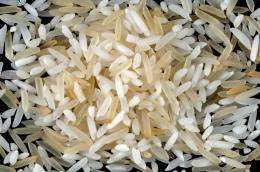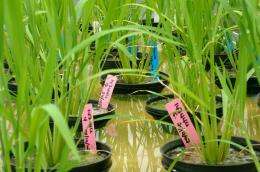Study reveals good news about the GI of rice

(Phys.org) -- Research analyzing 235 types of rice from around the world has found its glycemic index (GI) varies from one type of rice to another with most varieties scoring a low to medium GI.
This finding is good news because it not only means rice can be part of a healthy diet for the average consumer, it also means people with diabetes, or at risk of diabetes, can select the right rice to help maintain a healthy, low GI diet.
The study found that the GI of rice ranges from a low of 48 to a high of 92, with an average of 64, and that the GI of rice depends on the type of rice consumed.
The research team from the International Rice Research Institute (IRRI) and CSIRO’s Food Futures Flagship also identified the key gene that determines the GI of rice, an important achievement that offers rice breeders the opportunity to develop varieties with different GI levels to meet consumer needs. Future development of low GI rice would also enable food manufactures to develop new, low GI food products based on rice.
Dr. Melissa Fitzgerald, who led the IRRI team, said GI is a measure of the relative ability of carbohydrates in foods to raise blood sugar levels after eating.

“Understanding that different types of rice have different GI values allows rice consumers to make informed choices about the sort of rice they want to eat,” she said.
“Rice varieties like India’s most widely grown rice variety, Swarna, have a low GI and varieties like Doongara and Basmati from Australia have a medium GI.”
Dr. Tony Bird, CSIRO Food Futures Flagship researcher, said that low GI diets offer a range of health benefits.
“Low GI diets can reduce the likelihood of developing Type 2 diabetes, and are also useful for helping diabetics better manage their condition,” he said.
“This is good news for diabetics and people at risk of diabetes who are trying to control their condition through diet, as it means they can select the right rice to help maintain a healthy, low GI diet.”
Low GI foods are those measured 55 and less, medium GI are those measured between 56 and 69, while high GI measures 70 and above.
When food is measured to have a ’high GI‘, it means it is easily digested and absorbed by the body, which often results in fluctuations in blood sugar levels that can increase chances of getting diabetes, and make management of Type 2 diabetes difficult.
Conversely, foods with low GI are those that have slow digestion and absorption rates in the body, causing a gradual and sustained release of sugar into the blood, which has been proven beneficial to health, including reducing the chances of developing diabetes.
More information: Research paper: Fitzgerald, M. A., et al. 2011. Identification of a major genetic determinant of glycaemic index in rice. Rice 4(2): 66-74.
Provided by CSIRO















